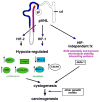The VHL tumor suppressor in development and disease: functional studies in mice by conditional gene targeting
- PMID: 15908240
- PMCID: PMC3787877
- DOI: 10.1016/j.semcdb.2005.03.006
The VHL tumor suppressor in development and disease: functional studies in mice by conditional gene targeting
Abstract
The von Hippel-Lindau tumor suppressor pVHL plays a critical role in the pathogenesis of familial and sporadic clear cell carcinomas of the kidney and hemangioblastomas of the retina and central nervous system. pVHL targets the oxygen sensitive alpha subunit of hypoxia-inducible factor (HIF) for proteasomal degradation, thus providing a direct link between tumorigenesis and molecular pathways critical for cellular adaptation to hypoxia. Cell type specific gene targeting of VHL in mice has demonstrated that proper pVHL mediated HIF proteolysis is fundamentally important for survival, proliferation and differentiation of many cell types and furthermore, that inactivation of pVHL may, unexpectedly, inhibit tumor growth under certain conditions. Mouse knock out studies have provided novel mechanistic insights into VHL associated tumorigenesis and established a central role for HIF in the development of the VHL phenotype.
Figures




Similar articles
-
Identification of cyclin D1 and other novel targets for the von Hippel-Lindau tumor suppressor gene by expression array analysis and investigation of cyclin D1 genotype as a modifier in von Hippel-Lindau disease.Cancer Res. 2002 Jul 1;62(13):3803-11. Cancer Res. 2002. PMID: 12097293
-
The VHL tumor suppressor and HIF: insights from genetic studies in mice.Cell Death Differ. 2008 Apr;15(4):650-9. doi: 10.1038/sj.cdd.4402313. Epub 2008 Jan 25. Cell Death Differ. 2008. PMID: 18219317 Free PMC article. Review.
-
The von Hippel-Lindau tumor suppressor protein and clear cell renal carcinoma.Clin Cancer Res. 2007 Jan 15;13(2 Pt 2):680s-684s. doi: 10.1158/1078-0432.CCR-06-1865. Clin Cancer Res. 2007. PMID: 17255293 Review.
-
The von Hippel-Lindau tumor suppressor gene and kidney cancer.Clin Cancer Res. 2004 Sep 15;10(18 Pt 2):6290S-5S. doi: 10.1158/1078-0432.CCR-sup-040025. Clin Cancer Res. 2004. PMID: 15448019 Review.
-
Identification of novel VHL target genes and relationship to hypoxic response pathways.Oncogene. 2005 Jun 30;24(28):4549-58. doi: 10.1038/sj.onc.1208649. Oncogene. 2005. PMID: 15824735
Cited by
-
A yeast two-hybrid system reconstituting substrate recognition of the von Hippel-Lindau tumor suppressor protein.Nucleic Acids Res. 2007;35(21):e142. doi: 10.1093/nar/gkm932. Epub 2007 Nov 5. Nucleic Acids Res. 2007. PMID: 17986458 Free PMC article.
-
Epidermal sensing of oxygen is essential for systemic hypoxic response.Cell. 2008 Apr 18;133(2):223-34. doi: 10.1016/j.cell.2008.02.038. Cell. 2008. PMID: 18423195 Free PMC article.
-
VHL deletion impairs mammary alveologenesis but is not sufficient for mammary tumorigenesis.Am J Pathol. 2010 May;176(5):2269-82. doi: 10.2353/ajpath.2010.090310. Epub 2010 Apr 9. Am J Pathol. 2010. PMID: 20382704 Free PMC article.
-
TBK1 Is a Synthetic Lethal Target in Cancer with VHL Loss.Cancer Discov. 2020 Mar;10(3):460-475. doi: 10.1158/2159-8290.CD-19-0837. Epub 2019 Dec 6. Cancer Discov. 2020. PMID: 31810986 Free PMC article.
-
Hypoxia-inducible factors in the kidney.Am J Physiol Renal Physiol. 2006 Aug;291(2):F271-81. doi: 10.1152/ajprenal.00071.2006. Epub 2006 Mar 22. Am J Physiol Renal Physiol. 2006. PMID: 16554418 Free PMC article. Review.
References
-
- Maher ER, Kaelin WG., Jr von Hippel–Lindau disease. Medicine (Baltimore) 1997;76:381–91. - PubMed
-
- Gnarra JR, Tory K, Weng Y, Schmidt L, Wei MH, Li H, et al. Mutations of the VHL tumour suppressor gene in renal carcinoma. Nat Genet. 1994;7:85–90. - PubMed
-
- Iliopoulos O, Kibel A, Gray S, Kaelin WG., Jr Tumour suppression by the human von Hippel–Lindau gene product. Nat Med. 1995;1:822–6. - PubMed
Publication types
MeSH terms
Substances
Grants and funding
LinkOut - more resources
Full Text Sources
Medical
Molecular Biology Databases

